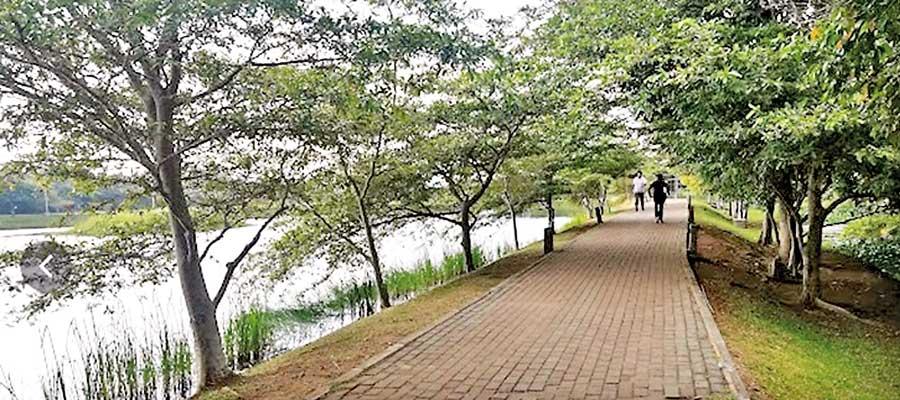09 Jun 2023 - {{hitsCtrl.values.hits}}

Jogging track in Gampaha
The case study presented in this article highlights the importance of having the correct for agencies responsible for managing environmentally sensitive areas, specifically focusing on the design and maintenance of jogging tracks in urban wetlands. The lack of a proper vision by the agency responsible for maintaining the jogging track along the Uruwal Oya stream in Gampaha Town has resulted in detrimental consequences for the ecosystem, particularly the fish culture in the stream.
The original vision behind the design of the jogging tracks was based on eco-friendly principles, aiming to create a sustainable and aesthetically pleasing environment. Riparian trees, such
|
Uruwal Oya |
as Kumbuk, were strategically planted along the stream banks to strengthen them and act as natural biofilters to protect the water from urban pollution. These trees not only provide shade for joggers but also played a crucial role in maintaining clean water in the stream.
During the construction phase, low-cost bioengineering technologies were employed to establish riverine trees along the eroded sections of the stream. Coir mats were used to protect the banks, and over time, the roots of the newly planted trees would take over the role of the mats. This approach was not only cost-effective but also aligned with the ecological objectives of the project.
The introduction of Gabion walls has eliminated the possibility of planting new riverine trees in the improved section
However, in the maintenance phase, the agency responsible for the track made a significant deviation from the original vision. They removed all the riverine trees along a stretch of the stream and replaced them with costly Gabion walls. The main objective behind this approach was to straighten the jogging track, which is unnecessary, as jogging tracks are not public roads that require straightening. The meandering nature of the tracks adds aesthetic value and enhances their function as nature trails.
Moreover, the introduction of Gabion walls has eliminated the possibility of planting new riverine trees in the improved section. The roots of trees would destabilize the Gabion walls, further exacerbating the issue. As a result, the track has lost its tree cover, which is an essential feature for joggers, and the Gabion walls cannot provide the same bio-filtering function as the riparian trees.
Gabion Section along Uruwal Oya bordering Gampaha Town by replacing riverine trees
The consequences of this misguided approach are evident in the present situation. The fish culture in the stream is dying due to polluted water, causing an unpleasant odour for joggers. Riparian trees, with their natural filtering capabilities, could have helped purify the water and prevent such pollution. Additionally, the removal of trees has disrupted the ecological balance, leading to issues like weed growth and loss of habitat for various plant and animal species.
Riparian trees offer numerous benefits beyond water purification. They stabilize the soil, prevent erosion, provide habitat for biodiversity, regulate climate, offer aesthetic and recreational value, support nutrient cycling, and promote biodiversity connectivity. By removing the trees, the agency has compromised these environmental services and the overall health and resilience of the riparian ecosystem.
Expected landscape of a typical Jogging Track cum Nature Trail
In conclusion, the case study emphasizes the importance of having the correct vision for agencies responsible for managing environmentally sensitive areas. The vision should be based on sustainable and eco-friendly principles, taking into account the specific needs and characteristics of the ecosystem. It should prioritize the preservation and restoration of riparian vegetation, recognizing its vital role in providing environmental services and ensuring the long-term health of the ecosystem. By aligning their actions with this vision, agencies can effectively manage and protect environmentally sensitive areas, contributing to the well-being of both nature and society.
The case study was done by
Mahinda Panapitiya
Consulting Engineer to PRDA who designed & Constructed
Gampaha Jogging Tracks
&
Prof. Hemanthi Ranasinghe, Senior Professor in Forestry and Environmental Sciences, University of Sri Jayewardenepura
10 Jan 2025 1 hours ago
10 Jan 2025 2 hours ago
10 Jan 2025 3 hours ago
10 Jan 2025 3 hours ago
10 Jan 2025 3 hours ago